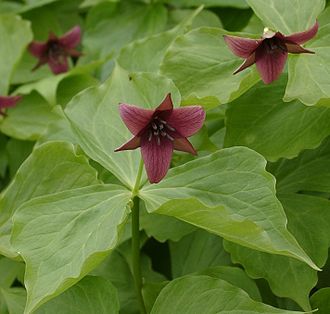Trillium

Trillium (trillium, wakerobin, tri flower, birthroot, birthwort, and sometimes “wood lily”) is a genus of about fifty flowering plant species in the family Melanthiaceae. Trillium species are native to temperate regions of North America and Asia,[3][4] with the greatest diversity of species found in the southern Appalachian Mountains in the southeastern United States.[5][6]
Plants of this genus are perennial herbs growing from rhizomes. There are three large leaf-like bracts arranged in a whorl about a scape that rises directly from the rhizome. There are no true aboveground leaves but sometimes there are scale-like leaves on the underground rhizome. The bracts are photosynthetic and are sometimes called leaves. The inflorescence is a single flower with three green or reddish sepals and three petals in shades of red, purple, pink, white, yellow, or green. At the center of the flower there are six stamens and three stigmas borne on a very short style, if any. The fruit is fleshy and capsule-like or berrylike. The seeds have large, oily elaiosomes.[3][4]
Occasionally individuals have four-fold symmetry, with four bracts (leaves), four sepals, and four petals in the blossom.[7][better source needed]
In 1753, Swedish botanist Carl Linnaeus established the genus Trillium by recognizing three species, T. cernuum, T. erectum, and T. sessile.[8] The type specimen T. cernuum described by Linnaeus was actually T. catesbaei,[9] an oversight that subsequently led to much confusion regarding the type species of this genus.
Initially the Trillium genus was placed in the family Liliaceae. In the nineteenth and early twentieth centuries it was sometimes placed in a smaller family, Trilliaceae.[10] By 1981 Liliaceae had grown to about 280 genera and 4,000 species.[11] As it became clearer that the very large version of Liliaceae was polyphyletic, some botanists preferred to place Trillium and related genera into that separate family. Others defined a larger family, Melanthiaceae, for a similar purpose, but included several other genera not historically recognized as close relatives of Trillium. This latter approach was followed in 1998 by the Angiosperm Phylogeny Group, which assigned the genus Trillium, along with its closest relatives, Paris and Pseudotrillium, to the family Melanthiaceae.[12] However, other taxonomists have since preferred to break up the heterogenous Melanthiaceae into several smaller monophyletic families, each with more coherent morphological features, returning Trillium to a resurrected Trilliaceae.[13][10]
The Trillium genus has traditionally been divided into two subgenera, T. subg. Trillium and T. subg. Sessilium, based on whether the flowers are pedicellate or sessile with respect to their attachment to the apex of the scape. The former is considered the more primitive group.[14][15][3] Until recently the sessile-flowered subgenus was known by the name Phyllantherum, but the name Sessilium has precedence and should be used instead.[16] T. subg. Sessilium has been shown to be a monophyletic group by molecular systematics but its segregation renders the remaining T. subg. Trillium paraphyletic.[17]
All names used in this section are taken from the International Plant Names Index.[18] Unless otherwise noted, the name has been accepted by World Checklist of Selected Plant Families.[19] The geographical locations are taken from the Flora of North America[3] except where noted.
